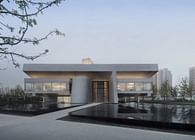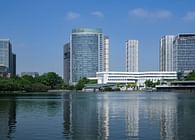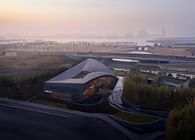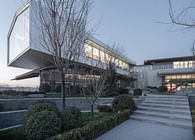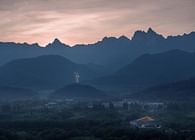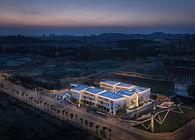
With the prevalence of rational consumerism, the traditional real estate design model of spending a lot of money to establish luxury sales offices is gradually disappearing. The sales office is one of the most important design elements in real estate design. It has now reached two extremes: the permanent sales office is constantly improving and pursuing high quality, while the temporary sales office is increasingly looking for rapid efficiency. And in the office, what you see is what you get, and is committed to presenting the vision of the future with exquisite architecture, pleasant space and beautiful environment. The temporary sales office reduces the construction period and investment cost as much as possible, and even adopts the construction method of container assembly to save time and cost.
Based on current trends, the project will explore and practice temporary mobile sales offices.
The project is located on a grassland beside the Beijing-Hangzhou Grand Canal in Xushuguan District, Suzhou. To the east is the CANLI Cultural and Creative Industry Park, which was converted from a building in the Republic of China. The building here is very short. The west side faces the Grand Canal with a wide view. The south and north are grasslands, and a few trees are scattered naturally. The canal, the houses of the Republic of China and the double pedestrian bridge on the grass and trees have become important spatial nodes, forming a unique place memory.
We use a 4.2m square as the modulus. The area of each module is 17.6 square meters, which can meet the requirements of basic space such as office management area and toilet. The sand table display shows a large space of 8m * 8m composed of four modules. As the largest functional space, the negotiation area requires 9 modules. In order to ensure that the height of each beam and longitudinal beam are the same, the height of the building is also 4.2m. Each plane grid becomes a three-dimensional module. Each module is divided into three categories: structural components (beams and columns), maintenance components (doors, windows and external wall panels), floor and roof. In order to facilitate disassembly and installation, all joints of the beam and column are riveted together.
There is a tree on the site. The sales office uses an L-shaped opening facing the tree, and two model houses are used to form a courtyard. The courtyard and trees become the visual focus of the building, and the entire visiting route is distributed around the courtyard. As the end of the activity line, the negotiation area leads to the Grand Canal. There are nine modules in the negotiation area. We launched the module towards the canal to form a protruding three-sided hanging box facing the canal, which was used as a tea house. The box leaves a courtyard at the center of the negotiation area. The negotiation area surrounds the courtyard, forming a natural closed circulation space inside and outside.
The building establishes a subtle relationship between space, light and transparency, so that people, architecture, activities and the environment together form a rich background. The building and the landscape share a grid system, and the constantly changing landscape grid acts as a transition of the third layer of space, thereby weakening the connection between the gray space and the site. The boundary between interior and exterior is blurred, and the blur of the boundary realizes the integration of space. When visitors walk between the inner space and the outer space, they will get a different feeling of space.
Colin Rowe divides transparency into physical transparency and phenomenon transparency. The hanging box at the bottom, the transparent maintenance structure and the thin white cylinder are physically transparent. The building is displayed on the site in the volume of a box, remaining close to "none". Outside the exhibition space, there is a gallery surrounding the gray space, which forms a transition layer between the building and the environment, extending infinitely into the gap. On the one hand, the internal space of the building shows signs of overflowing the building boundary; on the other hand, natural objects outside the building penetrate into the internal space through the glass wall and become a part of the internal space. The building is seen as a horizontal transparent overlap between the interior and exterior. The hanging box at the bottom can be regarded as the space between the sky and the earth. The two courtyards of the building can be regarded as the extension of the earth to the sky. The main part of the building is regarded as the overlapping part of the vertical transparent earth and the sky, realizing the space Phenomenological transparency on the Transparency here has not only spatial significance, but also empirical significance. As an exhibition hall, there is no single moving line setting, allowing users to move freely in different positions inside and outside. People can walk freely, touch buildings or establish physical connections to perceive the structure of buildings,
The design idea first involves the mechanical problems inside the frame structure, and directly focuses on the connection mode and space combination between the structures. The way of thinking considers the spatial structure, and the same framework produces various spatial forms due to the changes in spatial characteristics. Therefore, the final construction logic proposed by the building is the combination and splicing of different unit frame bodies. The pillars of the inner atrium expose the frame of the structural unit from the inside, and the repeated and uniform components reveal the relationship between the whole and the unit. Therefore, the feature of the unit frame is revealed, which is decomposable, recombinable, reusable and easy to transport.
Regeneration environment
The place where the building is located is itself a piece of reclaimed land. Through renovation and reconstruction, the old town has become a cultural and creative center full of urban vitality. The old place has gained a new life, and the vitality of the site has been updated on the basis of the renovation of the building and the reconstruction of the space.
Building regeneration
From the beginning of the design, the building has some functions, for example, it can be assembled and dismantled to bring the building to life. The contrast between the flowing liquid metal and the flowing space is the best illustration of regeneration. The flowing space can be adapted to different locations, and the transparent form can be integrated with a variety of different environments.
Project name free spring morning
Project location Xushuguan, Huqiu District, Suzhou City
Project Leader | Gemdale Group
Architecture Design | LACIME Architects
Head of Project | Ren Zhiguo
Design Team | Shi Dengke, Zhang Zhuo, Luo Yaxin, Liu Ying, Du Yixin
Landscape Design | Shanghai Marine Landscape Environmental Design Co., Ltd.
Interior Design CLV Interior Decoration Design (Tianjin) Co., Ltd.
Status: Built
Location: Suzhou, CN






